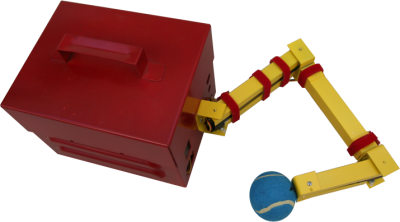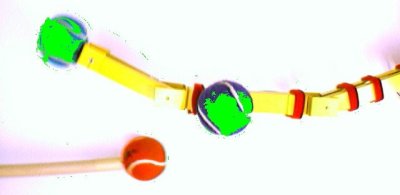Abstract: Robot Self-Recognition Using Conditional Probability–Based Contingency
This abstract was accepted to the 2006 AAAI Conference that was held in Boston. It was presented as a poster presentation. If you would like to cite this article, see below.
Introduction
As robots become more sophisticated and pervasive, they will be forced to operate in more dynamic and social environments. In order to develop a theory of mind to account for the intents, beliefs, and motivations of other individuals, a robot needs to be able to distinguish between another entity and itself. One proposed method of learning the difference between self and other is to use contingency, the time dependence of perception and action.
Watson (1994) suggested contingency as a method used by infants when learning to detect self. He outlined four general methods for detecting contingency: contiguity, temporal correlation, conditional probability, and causal implication.
For our experiment, we chose to implement Watson’s conditional probability method of contingency detection. Conditional probability keeps track of instances in which the behavior occurs and the stimulus does not, versus instances when the stimulus occurs but the behavior does not.
Previous Work
Our work was largely influenced by the Nico project at Yale University (Gold & Scassellati 2005). The Nico group used contingency detection by contiguity as a method for robotic self-detection. The robot randomly moved its arm while recording the minimum and maximum amount of time elapsed between a motor command and the perception of resulting movement. Then, in the detection stage, movements were classified as self if they fell within the learned window following a motor command. The robot detected itself rather robustly but it suffered a good deal of degradation in performance when presented with an anticipatory distractor. Anticipatory distractors will be described later in this paper.
Our Robot Platform
Our robot Narcissus (shown in figure 1) is a three-link, planar, robotic arm which is used in conjunction with a Firewire camera. Narcissus uses a single camera mounted above the arm to keep the arm within the visual field of the camera.
Watson’s outline for the conditional probability method of calculating contingency presupposes that (a) the agent can distinguish between separate objects in the environment and (b) tell that a given time has passed between a self-initiated action and the perception of movement of an object. In order to accomplish this we used some standard methods to segment objects from the scene using color and motion.

Figure 1: Narcissus is a three-link, planar, robotic arm. The blue tennis ball on the end of the arm is a color marker.
The Algorithm
The robot tracks objects and tries to determine if the objects are part of itself or not. Objects are colored markers in the scene. Some of these colored markers are attached to the robot, others are not attached. Unattached color markers are known as distractors. The robot arm can initiate an action—a command to move the arm to a new randomly-chosen pose. The robot records the timestamp the action was sent. When the robot detects that an object has started moving, it notes the timestamp and the object as a perception.
Training
The training mode collects time intervals between actions and perceptions. In training mode, a new action is initiated every 15 seconds and the timestamp is recorded. All perceptions that occur between this action and the next are considered to originate from the action. A timestamp is recorded for the first perception that occurs after the action. The interval between the action and the perception is calculated and recorded.
Training mode is stopped after a predetermined number of actions. The standard deviation and mean are calculated over the recorded action–perception time intervals to be used in the detection mode.
Conditional Probability and Contingency Indices
Watson’s conditional probability method of detecting contingency uses two indices: the sufficiency index and the necessity index. An action and perception are correlated if they both occur within a short period of time.
The sufficiency index is the probability of a stimulus given some specified time following a behavior:
 |
(1) |
|---|
For example, if you move your hand in front of your face, you expect to see your hand in front of your face.
The necessity index is the probability of a behavior given some time preceding a stimulus:
 |
(2) |
|---|
To use our example above, if you suddenly see your hand in front of your face, you expect that you performed the “move hand in front of face” action very recently.
By combining the two indices, a robust contingency detection method can be obtained. Watson proposes that if both of these indices are near or equal to 1.0, then contingency has been detected.
Detection
Every 15 seconds an action is initiated and the timestamp is recorded in a list, A. After each video frame is received, any new perceptions are recorded in a list, P, and the sufficiency and necessity indices are calculated.
To calculate the indices, we compare each recorded action timestamp to each recorded perception timestamp. An action and perception are considered to be correlated if the time interval between the action and perception (x) lies within three standard deviations (3σ) from the mean (μ) calculated in the training stage.
 |
(3) |
|---|
The correlated action–perception pair is added to a set, C.
For each object, the sufficiency index is the number of elements in C that correspond to the object divided by the total number of perceptions in P. The necessity index is the number of elements in C that correspond to the object divided by the total number of actions in A.
If the sufficiency and necessity indices are both greater than the threshold (0.8 in this work), then the object is labeled as self.
Results
Narcissus performed three runs using two different-colored markers attached to the robot. Each run consisted of 20 actions. The results of these runs are shown in the table below.
The robot also completed a single run with two different-color markers attached to itself and one anticipatory distractor. The distractor was a third colored marker moved around by the experimenter. The experimenter tried to time the movements of the distractor with the movements of the robot in an attempt to get the robot to consider the distractor part of itself. Despite the presence of the distractor (see figure 2), the robot correctly labeled the two color markers attached to its body as “self” during all 20 poses.
| Run | Object 1 | Object 2 |
|---|---|---|
| 1 | 100% | 100% |
| 2 | 100% | 90% |
| 3 | 85% | 85% |

Figure 2: The green pixels indicate which color markers the robot considers “self.” Narcissus recognizes the red anticipatory distractor as “other.”
Further Information
For further information about our robot Narcissus, the algorithm pseudo-code, source code, collected data, photos, mpeg movies, and an extended version of this paper, please visit our website at http://kevin.godby.org/projects/narcissus/.
Acknowledgements
We would like to thank Alex Stoytchev for his discussions and guidance and Jake Ingman for his photography skills.
References
- Gold, K., and Scassellati, B. 2005. Learning about the self and others through contingency. Palo Alto, CA: 2005 AAAI Spring Symposium on Developmental Robotics.
- Watson, J. S. 1994. Detection of self: The perfect algorithm. In Parker, S.; Mitchell, R.; and Boccia, M., eds., Self-Awareness in Animals and Humans: Developmental Perspectives. Cambridge University Press. chapter 8, 131–148.
Citation
If you would like to cite this paper, you may use the following:
- Godby, K. M. & Lane, J. A. (2006) Robot self-recognition: Using conditional probability–based contingency [Abstract]. In Proceedings of the Twenty-First National Conference on Artificial Intelligence. Menlo Park, Calif.: AAAI Press. Available online at http://kevin.godby.org/projects/narcissus/.
BibTEX entry:
@INPROCEEDINGS{Godby2006,
author = {Kevin M. Godby and Jesse A. Lane},
title = {Robot Self-Recognition Using Conditional Probability--Based Contingency},
booktitle = {Proceedings of the Twenty-First National Conference on Artificial Intelligence},
year = {2006},
address = {Menlo Park, Calif.},
publisher = {{AAAI} Press},
otherinfo = {Available online at \url{http://kevin.godby.org/projects/narcissus/}.}
}